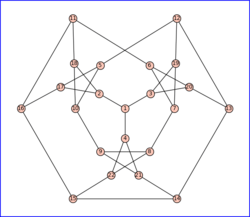Loupekine snarks
| Loupekine snark (first) | |
|---|---|
 The first Loupekine snark | |
| Vertices | 22 |
| Edges | 33 |
| Radius | 3 |
| Diameter | 4 |
| Girth | 5 |
| Chromatic number | 3 |
| Chromatic index | 4 |
| Properties | not planar |
| Table of graphs and parameters | |
| Loupekine snark (second) | |
|---|---|
 The second Loupekine snark | |
| Vertices | 22 |
| Edges | 33 |
| Radius | 3 |
| Diameter | 4 |
| Girth | 5 |
| Chromatic number | 3 |
| Chromatic index | 4 |
| Properties | not planar |
| Table of graphs and parameters | |
In the mathematical field of graph theory, the Loupekine snarks are two snarks, both with 22 vertices and 33 edges.
The first Loupekine snark graph can be described as follows (using the SageMath's syntax[1]):
- lou1 = Graph({1:[2,3,4],
- 5:[6,10],6:[7],7:[8],8:[9],9:[10],
- 11:[16,12],12:[13],13:[14],14:[15],15:[16],
- 17:[2,5,16],18:[2,10,11], 19:[3,7,12],20:[3,6,13], 21:[9,4,14],22:[4,8,15]}).
The second Loupekine snark is obtained (up to an isomorphism) by replacing edges 5–6 and 11–12 by edges 5–12 and 6–11 in the first graph.
Properties
Both snarks share the same invariants (as given in the boxes). The set of all the automorphisms of a graph is a group for the composition. For both Loupekine snarks, this group is the dihedral group (identified as [12,4] in the Small Groups Database). The orbits under the action of are :
- 1
- 2,3,4
- 17, 18, 19, 20, 21, 22
- 5, 6, 7, 8, 9, 10, 11, 12, 13, 14, 15, 16
The characteristic polynomials are different, namely:
and
References
This article is issued from
Wikipedia.
The text is licensed under Creative Commons - Attribution - Sharealike.
Additional terms may apply for the media files.